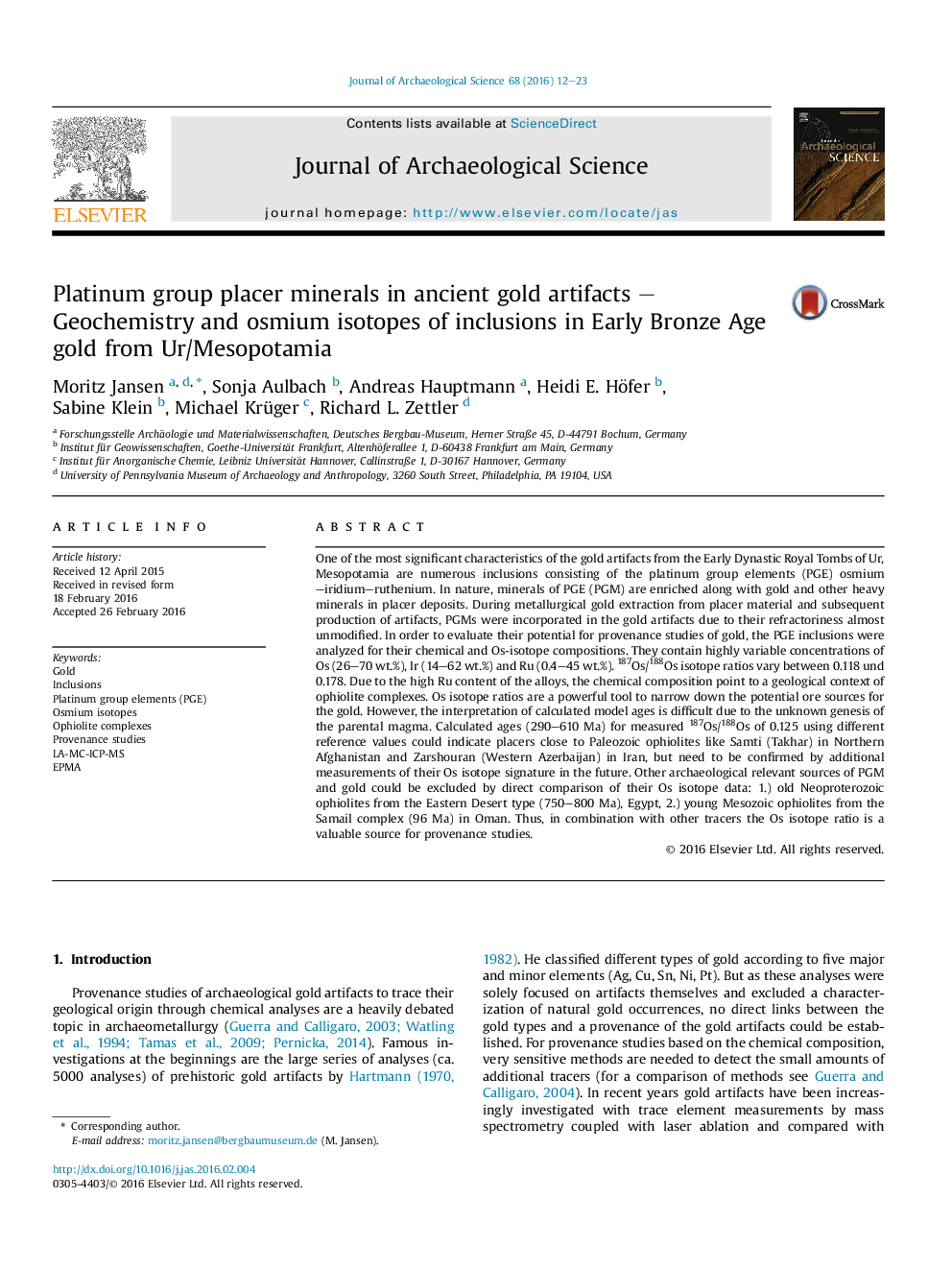| کد مقاله | کد نشریه | سال انتشار | مقاله انگلیسی | نسخه تمام متن |
|---|---|---|---|---|
| 7441513 | 1483892 | 2016 | 12 صفحه PDF | دانلود رایگان |
عنوان انگلیسی مقاله ISI
Platinum group placer minerals in ancient gold artifacts - Geochemistry and osmium isotopes of inclusions in Early Bronze Age gold from Ur/Mesopotamia
ترجمه فارسی عنوان
مواد معدنی پلاتین در جاهای مختلف در آثار باستانی طلا - ایزوتوپ های ژئو شیمی و اسیوییم در طلای زودرس برنز از اور / بین النهرین
دانلود مقاله + سفارش ترجمه
دانلود مقاله ISI انگلیسی
رایگان برای ایرانیان
کلمات کلیدی
موضوعات مرتبط
مهندسی و علوم پایه
مهندسی مواد
دانش مواد (عمومی)
چکیده انگلیسی
One of the most significant characteristics of the gold artifacts from the Early Dynastic Royal Tombs of Ur, Mesopotamia are numerous inclusions consisting of the platinum group elements (PGE) osmium-iridium-ruthenium. In nature, minerals of PGE (PGM) are enriched along with gold and other heavy minerals in placer deposits. During metallurgical gold extraction from placer material and subsequent production of artifacts, PGMs were incorporated in the gold artifacts due to their refractoriness almost unmodified. In order to evaluate their potential for provenance studies of gold, the PGE inclusions were analyzed for their chemical and Os-isotope compositions. They contain highly variable concentrations of Os (26-70Â wt.%), Ir (14-62Â wt.%) and Ru (0.4-45Â wt.%). 187Os/188Os isotope ratios vary between 0.118 und 0.178. Due to the high Ru content of the alloys, the chemical composition point to a geological context of ophiolite complexes. Os isotope ratios are a powerful tool to narrow down the potential ore sources for the gold. However, the interpretation of calculated model ages is difficult due to the unknown genesis of the parental magma. Calculated ages (290-610Â Ma) for measured 187Os/188Os of 0.125 using different reference values could indicate placers close to Paleozoic ophiolites like Samti (Takhar) in Northern Afghanistan and Zarshouran (Western Azerbaijan) in Iran, but need to be confirmed by additional measurements of their Os isotope signature in the future. Other archaeological relevant sources of PGM and gold could be excluded by direct comparison of their Os isotope data: 1.) old Neoproterozoic ophiolites from the Eastern Desert type (750-800Â Ma), Egypt, 2.) young Mesozoic ophiolites from the Samail complex (96Â Ma) in Oman. Thus, in combination with other tracers the Os isotope ratio is a valuable source for provenance studies.
ناشر
Database: Elsevier - ScienceDirect (ساینس دایرکت)
Journal: Journal of Archaeological Science - Volume 68, April 2016, Pages 12-23
Journal: Journal of Archaeological Science - Volume 68, April 2016, Pages 12-23
نویسندگان
Moritz Jansen, Sonja Aulbach, Andreas Hauptmann, Heidi E. Höfer, Sabine Klein, Michael Krüger, Richard L. Zettler,
